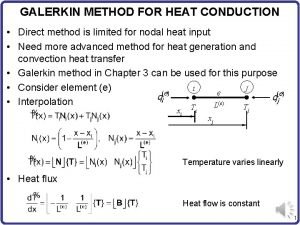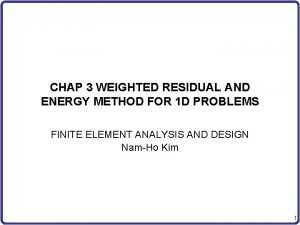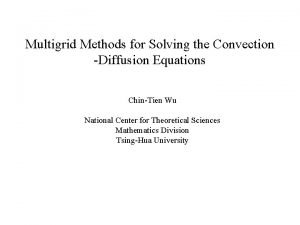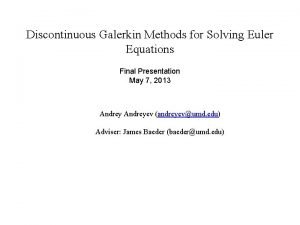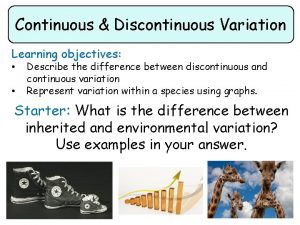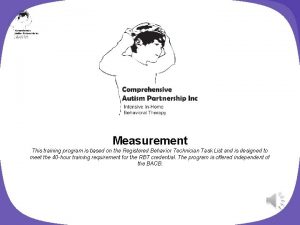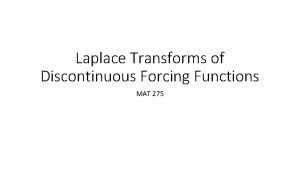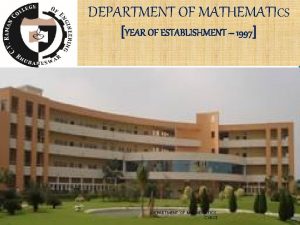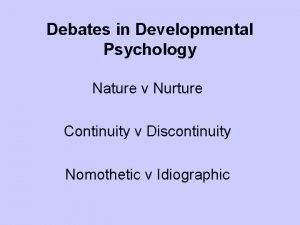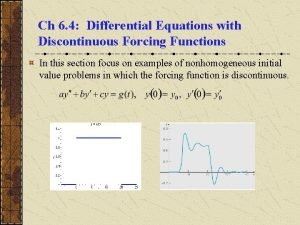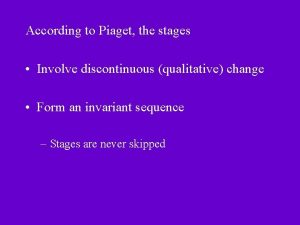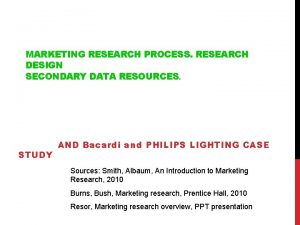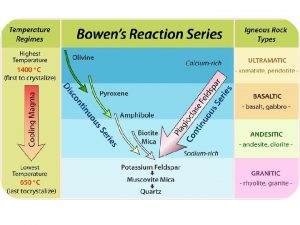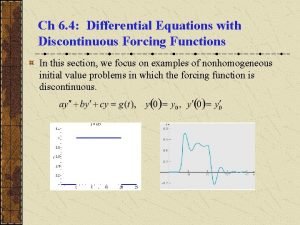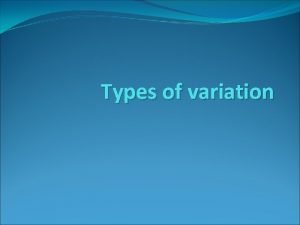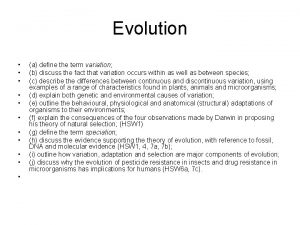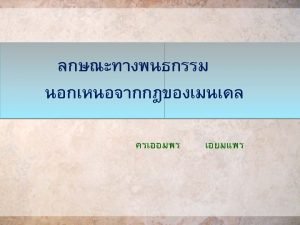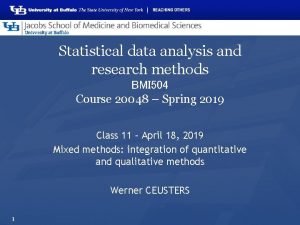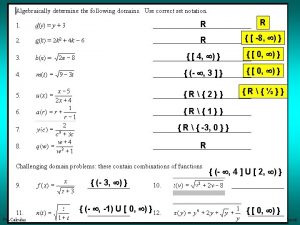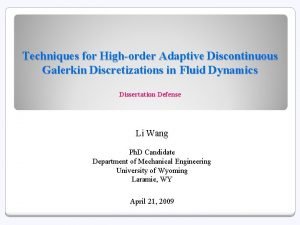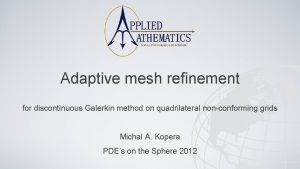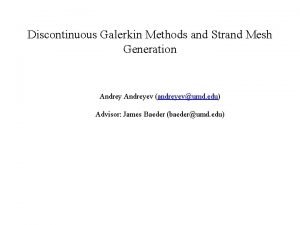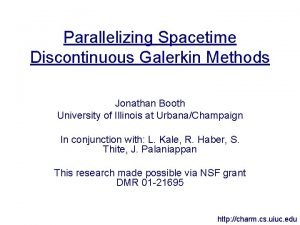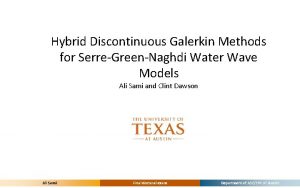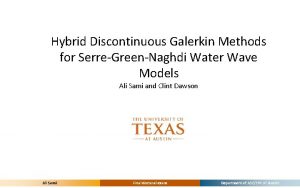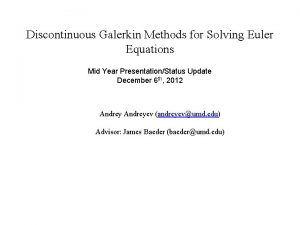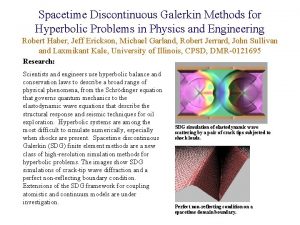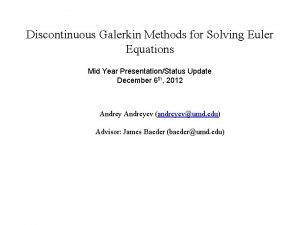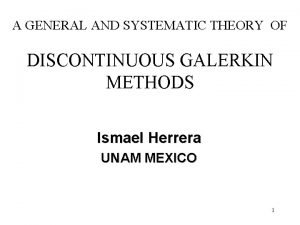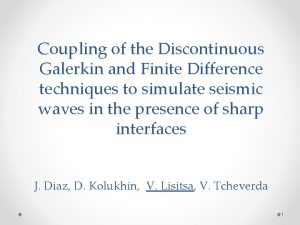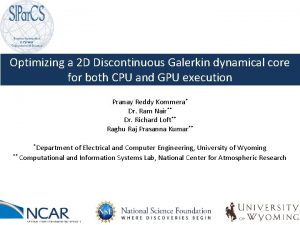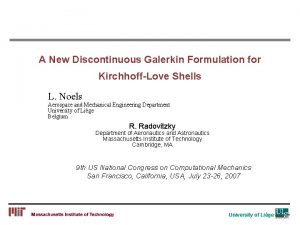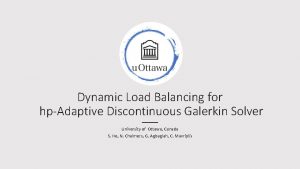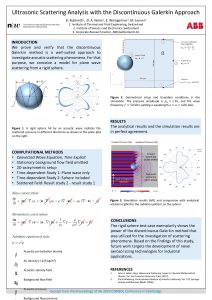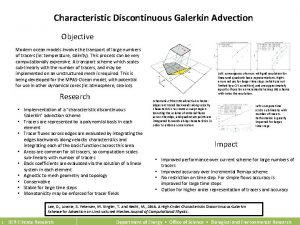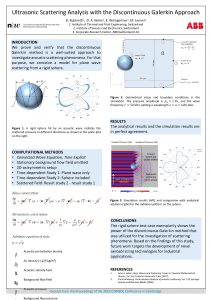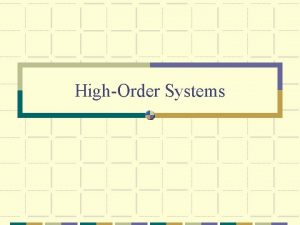HighOrder Adaptive and Parallel Discontinuous Galerkin Methods for









































- Slides: 41

High-Order Adaptive and Parallel Discontinuous Galerkin Methods for Hyperbolic Conservation Laws J. E. Flaherty, L. Krivodonova, J. F. Remacle, and M. S. Shephard Scientific Computation Research Center

Discontinuous Galerkin Method • Arbitrary order: extends finite volume method • Structured or unstructured meshes • No need for inter-element continuity – Simplifies adaptive h- and p-refinement

Discontinuous Galerkin Method • Face-based communication – Simplifies parallel computation • Sharp capturing of discontinuities • Element level conservation • A posteriori error estimates

Discontinuous Galerkin Method • Face-based communication – Simplifies parallel computation • Sharp capturing of discontinuities • Element level conservation • A posteriori error estimates However: • More mesh unknowns than FEM for same order • Possibly OK with parallel computation • Monotonicty control (limiting) is difficult

DG Formulation l Conservation law l Construct a Galerkin problem on j – cf. Cockburn and Shu (1989)

DG Solution l Solving the Galerkin problem Approximation Flux evaluation, limiting Time integration Integral evaluation

Higher order equations l Discontinuous approximations needs regularization for gradients

Example

Approximation lu Uj Pjp L 2( j ) – Orthogonal basis

Time Integration l Explicit Runge-Kutta – TVB method of Cockburn and Shu (1989) – Local time stepping, Remacle et al. (2002) t x

Flux Evaluation l Approximate fn(Uj) by a numerical flux Fn(Uj, Unbj) – Define Fn(Uj, Unbj) by a Riemann problem l Possibilities: – Upwind: flux from inflow neighbor – Lax-Friedrichs: • | max| is the maximum absolute eigenvalue of fu – Roe: linearized Riemann problem – van Leer: flux vector splitting – Colella-Woodward: contact surface resolution

Limiting: suppress spurious oscillations when p > 0 while maintaining order – Slope limiter: Cockburn and Shu (1989) – Curvature limiter: Barth (1990) – Moment limiter: Biswas et al. (1994) – Filtering: Gottlieb et al. (1999) l No robust procedures for multi-dimensional situations l

Slope vs. Moment Limiting Kinematic wave equation: ut + ux = 0 p=2 Slope Limiting Moment Limiting

Superconvergence l One-dimensional conservation law l Superconvergence at Radau points – Adjerid et al. (1995) – Biswas et al. (1994)

Superconvergence l Theorem: If p > 0, the spatial discretization error of the DG method with Uj Pp on [xj-1, xj] satisfies l Proof: Use Galerkin orthogonality, properties of Legendre polynomials, and “strong” superconvergence at downwind element ends – cf. Adjerid et al. (2002)

A Posteriori Error Estimation l One-dimensional l DG method l Error estimate conservation law

Superconvergence in p l If l f(u) = au: ut + aux = 0 –p=0 – 8 elements

Superconvergence in p l If l f(u) = au: ut + aux = 0 –p=1 – 8 elements

Superconvergence in p l If l f(u) = au: ut + aux = 0 –p=2 – 8 elements

Superconvergence in p l If l f(u) = au: ut + aux = 0 –p=3 – 8 elements

Superconvergence in p l If l f(u) = au: ut + aux = 0 –p=4 – 8 elements

Solitary Waves Nonlinear model: l Exact solution: l Solution at t = 1 Effectivity indices at t = 1

Two-Dimensional Problems l Steady linear conservation law l DG formulation – U Pp is the DG solution – j- is the inflow boundary of j – j+ outflow boundary of j

Error Estimation l Subtract the exact solution and use the Divergence Theorem l Assume the error has a series expansion – h is a mesh parameter

Error Estimation l Use an “induction” argument to show l Orthogonal basis (on canonical triangle)

Error Estimation l Show that – 2 D Radau polynomial? – Krivodonova and Flaherty (2001) l Strong superconvergence

A Posteriori Error Estimation l Solve the exit flow and DG problem – Complexity is O(p) per element

Example l Consider – = (0, 1) x (0, 1) – Exact solution

Error Estimates N p 16 ||e||0 56 ||e||0 160 ||e||0 0 4. 85 e-2 1. 0116 2. 49 e-4 1. 0304 1. 49 e-2 1. 0418 1 8. 27 e-4 1. 0022 2. 16 e-4 1. 0537 7. 85 e-5 1. 0266 2 3. 11 e-5 0. 9609 4. 16 e-6 0. 9267 9. 24 e-7 0. 9054 3 1. 71 e-6 1. 0161 1. 04 e-7 1. 0546 1. 47 e-8 1. 0054 4 1. 07 e-7 1. 0597 3. 32 e-9 1. 0097 2. 8 e-10 0. 9203

Superconvergence 8 N p I- 32 I+ I- 128 I+ I- I+ 0 1. 08 e-1 1. 07 e-2 5. 57 e-2 5. 08 e-3 2. 11 e-2 2. 47 e-3 1 2. 23 e-3 7. 53 e-6 6. 02 e-4 8. 95 e-7 1. 56 e-4 1. 09 e-7 2 7. 56 e-5 1. 98 e-8 1. 07 e-5 4. 8 e-10 1. 43 e-6 1. 8 e-11 3 3. 02 e-6 8. 3 e-11 2. 25 e-7 6. 2 e-13 1. 55 e-8 5. 4 e-15

Linear Functional l Barth and Larson (2002), Barth (2002) l Functional

Superconvergence h 1/13 p I+ 1/26 I+ 1/52 1/104 r I+ r 0 1. 72 e-2 7. 09 e-3 2. 40 3. 72 e-3 1. 91 1. 89 e-3 1. 96 1 2. 32 e-4 1. 68 e-5 13. 8 2. 17 e-6 7. 74 2. 74 e-7 7. 92 2 1. 28 e-6 2. 47 e-8 51. 8 1. 10 e-9 22. 5 3. 74 e-11 29. 4 3 3. 22 e-7 9. 1 e-10 353 7. 72 e-12 118

Rayleigh-Taylor Instability Heavy fluid above a lighter one l Subject to a perturbation l DG method – Roe numerical flux – Limiting: reduce p by one if temperature becomes negative – Enrichment indicator l 1/2 1/4

Adaptive h-Refinement t = 0. 5 t= 1 t = 1. 5 t = 1. 9

p-Refinement DOF p=0 p=1 p=2 p=3 3040 9120 18240 30400

Vortex sheet

Blast

Perforated Shock Tube l l l Mach 1. 23 flow in tube Rupture a diaphragm between the tube and vent DG method with p = 0 Local time stepping Parallel computation Compare results with Nagamatsu et al. (1987)

Adaptive Analysis

Adaptivity

Discussion l Stabilization (limiting) – Unstructured meshes Viscosity: Navier-Stokes equations l Implicit time integration l – Space-time DG method l A posteriori error estimation – Discontinuities – Space-time coordination – Multi-dimensional superconvergence? l Adaptive strategies – Optimal enrichment (with parallel computation)
 Galerkin method
Galerkin method Galerkin method
Galerkin method Galerkin
Galerkin Spatial discretization
Spatial discretization Difference between continuous and discontinuous variation
Difference between continuous and discontinuous variation Difference between continuous and discontinuous variation
Difference between continuous and discontinuous variation Difference between continuous and discontinuous variation
Difference between continuous and discontinuous variation Discontinuous measurement procedures
Discontinuous measurement procedures Discontinuous forcing functions
Discontinuous forcing functions Dirichlet discontinuous factor
Dirichlet discontinuous factor Discontinuous development psychology
Discontinuous development psychology Discontinuous development psychology
Discontinuous development psychology Discontinuous development psychology
Discontinuous development psychology Discontinuous development psychology
Discontinuous development psychology Differential equations with discontinuous forcing functions
Differential equations with discontinuous forcing functions Piaget discontinuous development
Piaget discontinuous development Continuous panel vs discontinuous panel
Continuous panel vs discontinuous panel Why are atomic emission spectra discontinuous
Why are atomic emission spectra discontinuous Discontinuous reaction series
Discontinuous reaction series Differential equations with discontinuous forcing functions
Differential equations with discontinuous forcing functions Discontinuous variation
Discontinuous variation Physiological adaptation example
Physiological adaptation example Dihibrid cross
Dihibrid cross Metal coping fpd
Metal coping fpd Define like and unlike force
Define like and unlike force Parallelism
Parallelism Parallelism sentence
Parallelism sentence Parallel and non parallel structure
Parallel and non parallel structure What is parallelism examples
What is parallelism examples Convergent parallel mixed methods
Convergent parallel mixed methods Iso 22301 utbildning
Iso 22301 utbildning Typiska novell drag
Typiska novell drag Nationell inriktning för artificiell intelligens
Nationell inriktning för artificiell intelligens Vad står k.r.å.k.a.n för
Vad står k.r.å.k.a.n för Varför kallas perioden 1918-1939 för mellankrigstiden?
Varför kallas perioden 1918-1939 för mellankrigstiden? En lathund för arbete med kontinuitetshantering
En lathund för arbete med kontinuitetshantering Särskild löneskatt för pensionskostnader
Särskild löneskatt för pensionskostnader Personlig tidbok fylla i
Personlig tidbok fylla i Sura för anatom
Sura för anatom Vad är densitet
Vad är densitet Datorkunskap för nybörjare
Datorkunskap för nybörjare Boverket ka
Boverket ka
